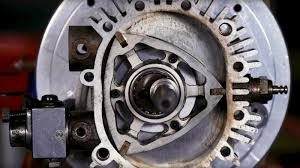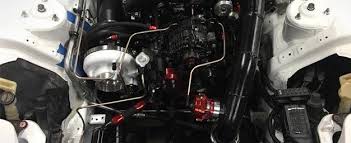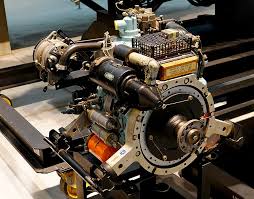Why Do Rotary Engines Offer Bad Mileage?
The rotary engine has a constant
crankshaft, and the corresponding cylinder block revolves around it. The engine
has its plus points and some drawbacks, but the low mileage offered by the
rotary engine is the matter of concern.
1. The Inefficient Engines
The thing is; the rotary engines end
up producing excessive power. The engines, in turn, are not built to handle the
excessive power. As a matter of fact, the more power the more fuel
is burnt as the revs of the vehicle get higher. This is the simplest
reasons that explain why rotary engines offer a bad mileage.
2. Seal Leakages
The temperatures of each chamber of
the engine house differ. This tends to be problematic when the
diverse expansion coefficients of the materials lead to faulty sealing.
Furthermore, a case of seal leakages occurs that results in leakages of
combustion gas into the other chambers. Such wastage of gas directly means low
fuel economy.
3. Low Compression Ratio
Compression ratio is the overall ratio of
the maximum and the smallest volume of the cylinder at any given point within
the internal combustion engine. The best compression ratio that has been
recorded on a rotary engine is 11:1, which is not okay in terms of what modern
engines can offer. The best compression ratio for a petrol engine is 10:1.
4. Long Combustion Chamber
The combustion chamber of a rotary engine
is designed to be very long. This may work well to some extent, but the high
surface area to volume ratio makes things tricky. You may ask, ”How may it
affect the fuel consumption,” to which the answer lies in the extended cooling
time of the fluids. If the cooling is suffered, so is the overall fuel economy.
5. The Case Of Fixed Ports
The valves or camshafts are missing in a rotary
engine. This problem with the rotary engines leads to the
inability of meddling with the valve timings, i.e., the case of “no valve
timing.” The port time can only be changed by machining the ports of altering
the piston skirt. So, when the valves do not open and close at a synchronized
timing, the engine performance deteriorates. In simple words, the rotary
engine fuel economy turns out to be bad.

The most common mistake made by rotary enthusiasts
intent on supercharging their engines is to supercharge a stock, unmodified
non-turbo engine.
Unless you are content to use the power
gain only occasionally, and even then only briefly, you run the very serious
risk of catastrophic engine failure. Sustained use generally brings failure,
and the more common failures include broken apex seals and flattened apex seal
springs. On occasion a stationary gear breaks, or a rotor gear moves away from
the rotor and jams against a side housing, or a bearing fails due to
overheating. With any of these failures, a complete engine rebuild is required.
The causes of these problems, and others,
are many. Superchargers generate heat loads well in excess of what a stock
engine can handle: the stock water and oil cooling systems are overwhelmed and
simply cannot carry away the excess heat fast enough.
Additionally, the compression ratio
commonly found in non-turbo engines is not low enough for supercharger
applications. Depending on horsepower requirements, a compression ratio as low
as 7.5:1 may be in order for reliable operation. The higher the boost level you
desire to run, the greater the likelihood you will need to address the issue of
a lowered compression ratio. In our experience, we have found that 5 psi.,
approximately, is the threshold above which the stock, non-turbo compression
ratio is no longer appropriate.
As the above comments would suggest, we do
not recommend supercharging an otherwise stock, “non-turbo-based”
unmodified engine. When you weigh the anticipated power gains against the very
real likelihood of a premature, and costly, engine failure it’s likely not
worth the headaches.
If you are willing to build an engine that
is capable of handling the increased heat loads that superchargers develop, the
following tips will prove beneficial, increasing the likelihood of a long-life
engine.

How It Works
A rotary engine is a barrel-shaped internal
combustion engine that lacks many of the major parts you’d find in a
conventional piston engine. For one thing, there are no pistons chugging up and
down. Rather, rounded triangular rotors—most often two, but sometimes one or
three—spin around a shaft through the hollow barrel.
Fuel and air are pumped into the spaces
between the rotors’ sides and interior walls of the barrel, where they ignite.
The rapid expansion of exploding gases turns the rotors, thus generating power.
The rotors fulfill the same task as pistons in a piston engine, but with far
fewer moving parts, making a rotary engine lighter and smaller than a piston
engine of equivalent displacement.
The basic design is a century-old one.
Felix Wankel himself was a German engineer who came up with his version of a
rotary engine in the 1920s. Being busy with warmongering on behalf of the Nazi
party, however, he didn’t get the chance to develop his vision too far until
1951, when German automaker NSU invited him to design a prototype.

Wankel
Engines
Try not to get caught up in the semantics
of what to call this engine. Commonly referred to as a rotary engine (even by
Mazda, though often this refers to a rotating piston-cylinder-based layout),
the Wankel engine was last used in production in the Mazda RX-8. There are no
pistons, camshafts, or connecting rods.
Advantages
- Simplicity: rotary engines can have as few as three main moving parts, versus more than 40+ for piston-cylinder based engines. Fewer moving parts typically leads to better reliability.
- No reciprocating mass: this allows rotary engines to rev high, and also run very smoothly.
- Weight: rotary engines are compact and offer great power-to-weight ratios.
- Power delivery: because of the way a rotor rotates, power delivery lasts for more of the rotation of the crankshaft versus a piston-cylinder engine, resulting in super smooth power delivery.
- Size: rotary engines are compact, allowing for easy packaging.
Disadvantages
- Fuel economy: the exhaust often
includes unburned fuel, on top of which Wankel engines typically have low
compression ratios, resulting in poor fuel efficiency.
- Emissions: unburned
hydrocarbons leaving the exhaust makes it difficult to pass emissions
regulations.
- Rotor sealing: due to the
varying temperatures throughout the combustion chamber, the apex seals expand
and contract making it difficult to create a good seal, leading to inefficient
power production.
- Oil burning: by design, Mazda
Wankel engines burn oil to help maintain the longevity of the apex seals. Not
only does this further increase exhaust emissions, but it requires the owner to
add oil periodically.
Mechanical Operation
A rotary engine uses a triangular-shaped
rotor to divide the space inside the engine, enabling a standard four-stroke
cycle of intake, compression, ignition and exhaust. The moving rotor transports
fuel to the various engine compartments for each leg of the cycle. In this way,
it resembles a reciprocating piston engine. Rotary engines can be built with
any number of rotors, much like the multiple number of cylinders offered in
piston engines. The rotors engage a drive shaft, which then powers the
vehicle’s drive mechanism (the propeller of a plane, or wheels of a car).
Simplicity
One of the major advantages of a rotary
engine is its mechanical simplicity. A rotary engine contains far fewer parts
than a comparable piston engine. This may decrease the cost of design and
manufacture. This also leads to decreased weight. Compared to standard
reciprocating piston engines, rotary engines contain no valves, camshaft,
rocker arms, timing belts or flywheel. All this means decreased weight, fewer
opportunities for malfunction and easier repair. When rotary engines were first
developed, they were used to power aircraft, taking advantage of the rotary
engine’s high power-to-weight ratio.